Home Fitness Equipment Market Size
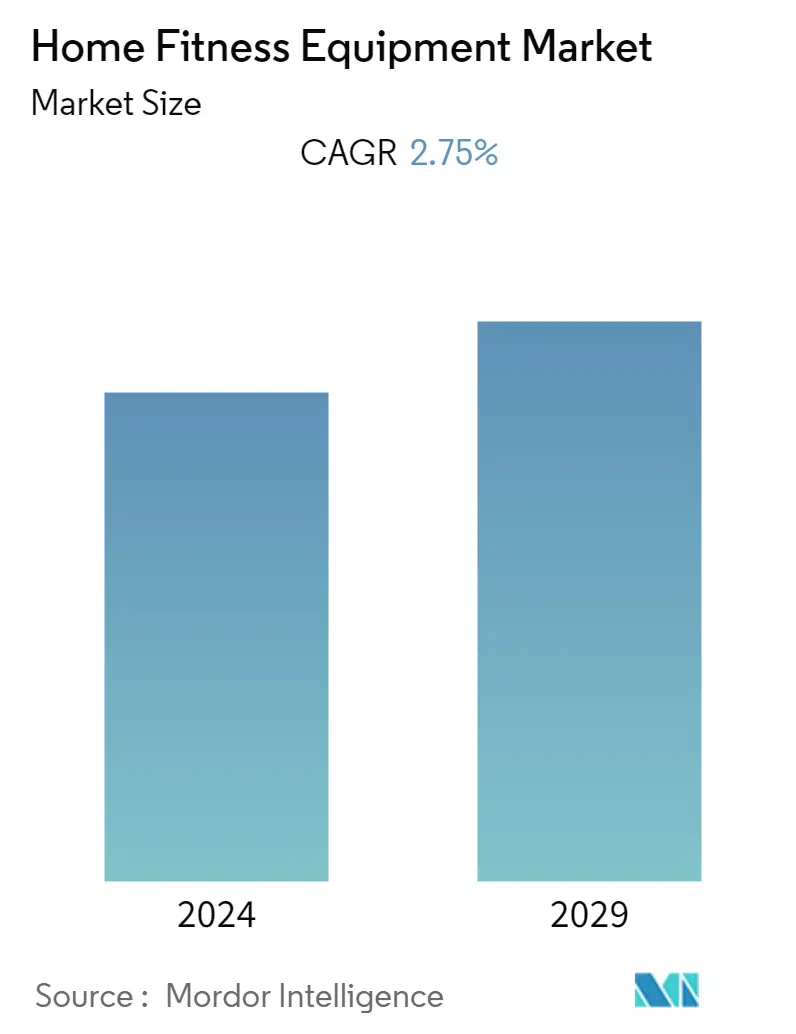
| Study Period | 2018 - 2029 |
| Base Year For Estimation | 2023 |
| CAGR | 2.75 % |
| Fastest Growing Market | Asia Pacific |
| Largest Market | North America |
| Market Concentration | Low |
Major Players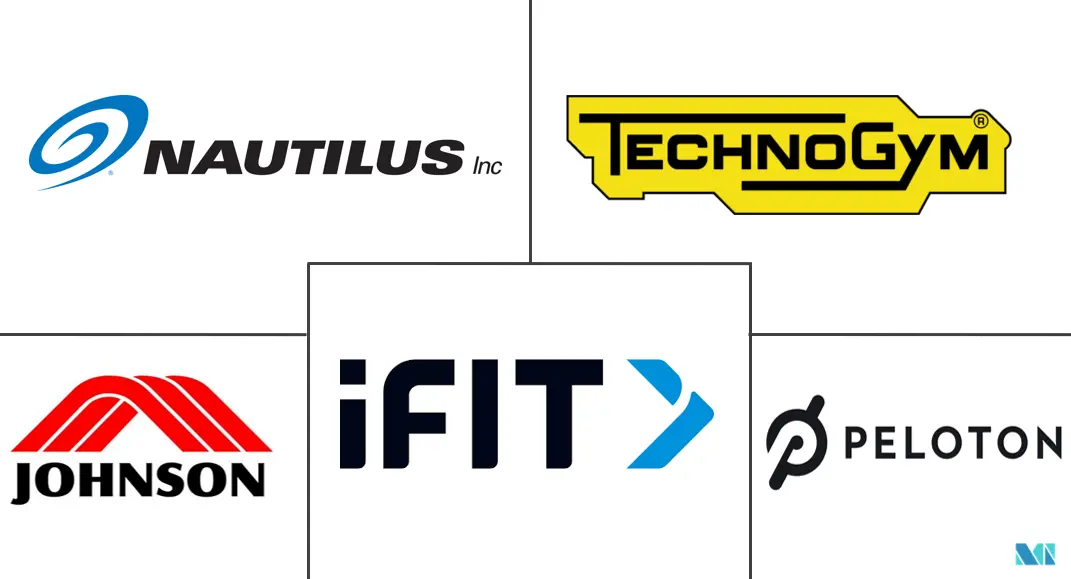
*Disclaimer: Major Players sorted in no particular order |
Home Fitness Equipment Market Analysis
The home fitness equipment market was valued at USD 13,741.23 million in the previous year and is projected to register a CAGR of 2.75% during the forecast period.
Over the short term, precautionary healthcare, coupled with an increasing preference for customized workout regimes (including workout timing) and a comfortable home-friendly environment, is increasing the demand for home fitness equipment as customers are keen to exercise daily. Growth in home fitness equipment in the recent past was also the result of the inconvenience of commuting to a gym to use the machines, trainer fees, and membership fees, primarily in developing countries. The space limitation, primarily for bulk fitness equipment, such as massage chairs, exercise bikes, exercise treadmills, and cross, is a major factor that limits the growth of the home fitness equipment market. This has stimulated start-up gyms, fitness centers, and health clubs worldwide.
Additionally, while not everyone can afford a fully equipped gym, there are various possibilities for small-scale training equipment. As a result, companies like Temple Studio are now offering an all-in-one home gym the size of a mini-fridge, costing just under USD 400. Furthermore, owing to the increasing popularity of smartphones, market players are offering customers the option of managing their services through mobile applications and websites. The e-health platforms are offering video-on-demand, live remote training, creating their own workout programs, and other offers that are self-operated and guided by experts. These associated benefits of e-health platforms have created huge demand among working and busy customers, and it is expected to remain trending in the future. Thus, e-health platforms, gyms, and fitness center consulting services are expected to drive the health and fitness equipment market.
Home Fitness Equipment Market Trends
This section covers the major market trends shaping the Home Fitness Equipment Market according to our research experts:
Rising Health Awareness Among the Consumers
Consumers are leveraging the benefits of digitally connected fitness equipment to enjoy a personalized training experience through online workout classes. Digital self-care platforms have become a critical building block for a safer and healthier future. Amid the COVID-19 pandemic, people have spent more time indoors, and keeping the body moving is important, both for physical health and mental well-being. Being away from their fitness club routines was inconvenient for regular gym goers. E-health and fitness platforms have been a few important tools to help people keep themselves fit and fine. Hence, the pandemic helped the home fitness equipment market penetrate further due to the change in the gymming and workout habits of people. In the current year, some of the online fitness platforms, such as Nike Training Club, TREAD, Adidas Training by Runtastic, HealthifyMe, and Daily Yoga, are offering a gym-like experience to the user, which is impacting physical fitness and health clubs negatively.
Home fitness equipment eliminates the inconvenience of commuting to a gym to use the machines and is highly cost-effective in the long run. Eventually, numerous innovations have occurred in this segment, such as launching apps that provide a platform for customers to select their trainers for either online classes or home visits, to meet the user's specific and customized fitness requirements, such as bodybuilding. Moreover, due to the rising awareness among consumers regarding their health, the demand for these types of equipment has also increased.
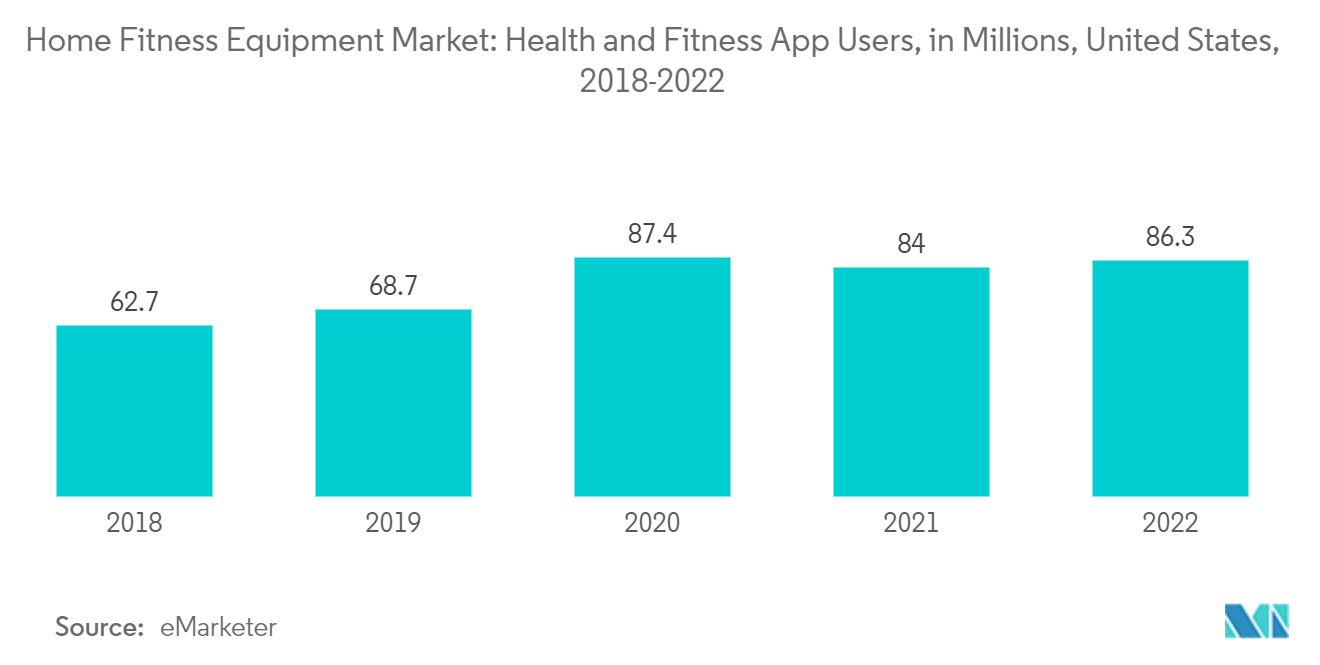
North America Leading the Home Fitness Equipment Market
The North American market witnessed significant growth due to the rising health awareness among consumers and the growing adoption of exercises related to physical well-being, weight management, and improving body stamina and muscular strength. The rising obese population and increasing health concerns are other major factors driving the home fitness equipment market in the region. The rising preventive healthcare measures and the augmenting healthcare costs enable consumers to engage in regular workouts to remain fit. With the growing demand, manufacturers operating in the global market are expanding their presence to achieve a competitive advantage. Moreover, due to the consumer's growing interest in in-home workouts, the demand for such home equipment is growing, which is also driving the home equipment market.
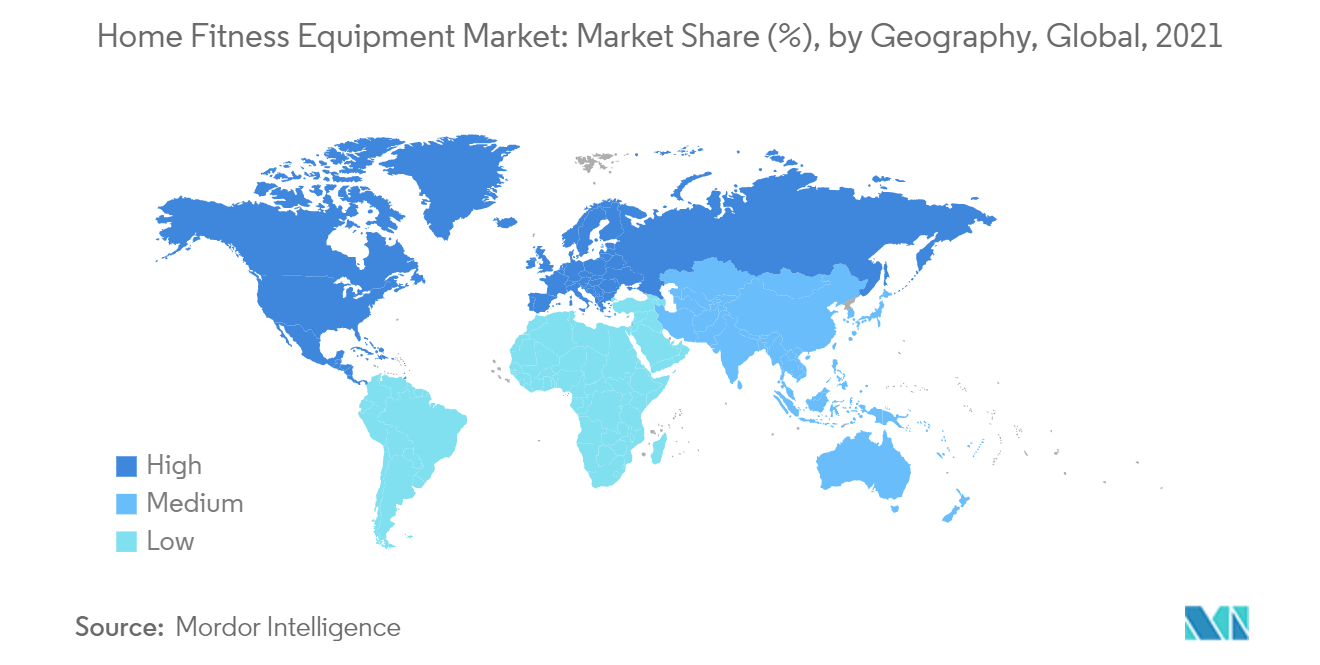
Home Fitness Equipment Industry Overview
The market studied is competitive in nature. This is due to the existence of several domestic and international players in this segment. The major players in this respective sector are Nautilus Inc., Icon Health & Fitness Inc., Johnson Health Tech Co. Ltd, Technogym SpA, and Peloton Interactive Inc. The key strategy adopted by these top players is product innovation and new product development, as it enables them to offer new products to the consumer. Some of the other players in the same segment opt for mergers and acquisitions as their key strategy, as it helps these top players capture a dominant position over other domestic players. This specific strategy also enables these players to break the ongoing chain of competition and rivalry among the other competitors.
Home Fitness Equipment Market Leaders
-
Nautilus Inc.
-
Johnson Health Tech Co. Ltd.
-
Technogym SpA
-
Peloton Interactive, Inc.
-
iFIT Health & Fitness Inc
*Disclaimer: Major Players sorted in no particular order
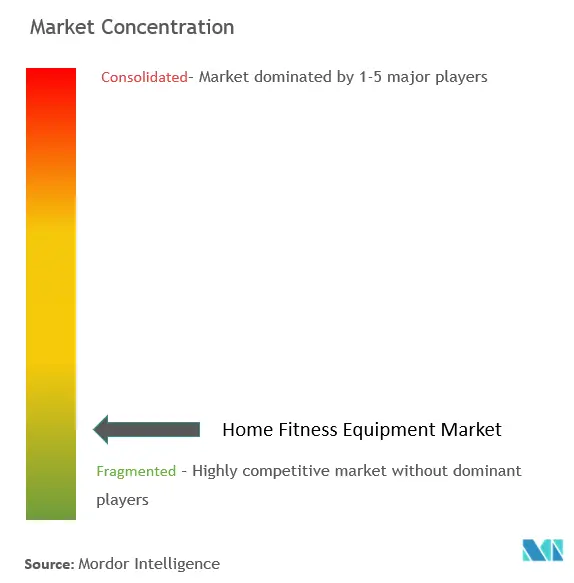
Home Fitness Equipment Market News
- August 2021: Johnson Health Tech Co. Ltd acquired Matrix Fitness South Africa, a distributor for JHT prior to the acquisition, becoming the first fitness equipment company to have a wholly-owned subsidiary in Africa. The major strategy behind this move was to expand the business in the African region, which will result in positive revenue growth in the long term.
- June 2021: ICON Health & Fitness announced that it changed its corporate name to iFIT Health & Fitness Inc. (iFIT). According to the firm, the change reflects iFIT's commitment to delivering personalized, connected health and fitness experiences to its growing community. Currently, iFIT has more than five million members in 120 countries.
- January 2021: Nautilus Inc. expanded connected home fitness products featuring the enhanced JRNY Digital Fitness Platform by introducing the next generation of the popular BowflexMax Trainer, which expanded the Bowflextreadmill line, helping members achieve their fitness goals by offering curated workouts and entertainment options that stream while being coached.
Home Fitness Equipment Market Report - Table of Contents
1. INTRODUCTION
- 1.1 Study Assumptions and Market Definition
- 1.2 Scope of the Study
2. RESEARCH METHODOLOGY
3. EXECUTIVE SUMMARY
4. MARKET DYNAMICS
- 4.1 Market Drivers
- 4.2 Market Restraints
-
4.3 Porter's Five Forces Analysis
- 4.3.1 Threat of New Entrants
- 4.3.2 Bargaining Power of Buyers/Consumers
- 4.3.3 Bargaining Power of Suppliers
- 4.3.4 Threat of Substitute Products
- 4.3.5 Intensity of Competitive Rivalry
5. MARKET SEGMENTATION
-
5.1 By Product Type
- 5.1.1 Treadmills
- 5.1.2 Elliptical Machines
- 5.1.3 Stationary Cycles
- 5.1.4 Rowing Machines
- 5.1.5 Strength Training Equipment
- 5.1.6 Other Product Types
-
5.2 By Distribution Channel
- 5.2.1 Offline Retail Stores
- 5.2.2 Online Retail Stores
- 5.2.3 Direct Selling
-
5.3 By Geography
- 5.3.1 North America
- 5.3.1.1 United States
- 5.3.1.2 Canada
- 5.3.1.3 Mexico
- 5.3.1.4 Rest of North America
- 5.3.2 Europe
- 5.3.2.1 United Kingdom
- 5.3.2.2 Germany
- 5.3.2.3 Spain
- 5.3.2.4 France
- 5.3.2.5 Italy
- 5.3.2.6 Russia
- 5.3.2.7 Rest of Europe
- 5.3.3 Asia-Pacific
- 5.3.3.1 China
- 5.3.3.2 Japan
- 5.3.3.3 India
- 5.3.3.4 Australia
- 5.3.3.5 Rest of Asia-Pacific
- 5.3.4 South America
- 5.3.4.1 Brazil
- 5.3.4.2 Argentina
- 5.3.4.3 Rest of South America
- 5.3.5 Middle East and Africa
- 5.3.5.1 South Africa
- 5.3.5.2 United Arab Emirates
- 5.3.5.3 Rest of Middle East and Africa
6. COMPETITIVE LANDSCAPE
- 6.1 Most Adopted Strategies
- 6.2 Market Share Analysis
-
6.3 Company Profiles
- 6.3.1 Anta International Limited (Amer Sports Oyj)
- 6.3.2 Nautilus Inc.
- 6.3.3 Johnson Health Tech Co. Ltd
- 6.3.4 Origin Fitness Ltd (Anytime Leisure Limited)
- 6.3.5 Dyaco International Inc.
- 6.3.6 Technogym SpA
- 6.3.7 Peloton Interactive Inc.
- 6.3.8 TRUE Fitness
- 6.3.9 Icon Health & Fitness Inc.
- 6.3.10 Decathlon SA
- *List Not Exhaustive
7. MARKET OPPORTUNITIES AND FUTURE TRENDS
8. IMPACT OF COVID-19 ON THE MARKET
** Subject To AvailablityHome Fitness Equipment Industry Segmentation
Home exercise/fitness equipment is any apparatus or device used during physical activity to enhance the strength or conditioning effects on the body. The home fitness equipment market is segmented by product type, distribution channel, and geography. Based on product type, the market is segmented into treadmills, elliptical machines, stationary cycles, rowing machines, strength training equipment, and other product types. Based on the distribution channels, the market is segmented into offline retail stores, online retail stores, and direct selling. The market is also segmented by geography into North America, Europe, Asia-Pacific, South America, and the Middle East and Africa. For each segment, the market sizing and forecasts have been done based on value (in USD million).
| By Product Type | Treadmills | |
| Elliptical Machines | ||
| Stationary Cycles | ||
| Rowing Machines | ||
| Strength Training Equipment | ||
| Other Product Types | ||
| By Distribution Channel | Offline Retail Stores | |
| Online Retail Stores | ||
| Direct Selling | ||
| By Geography | North America | United States |
| Canada | ||
| Mexico | ||
| Rest of North America | ||
| By Geography | Europe | United Kingdom |
| Germany | ||
| Spain | ||
| France | ||
| Italy | ||
| Russia | ||
| Rest of Europe | ||
| By Geography | Asia-Pacific | China |
| Japan | ||
| India | ||
| Australia | ||
| Rest of Asia-Pacific | ||
| By Geography | South America | Brazil |
| Argentina | ||
| Rest of South America | ||
| By Geography | Middle East and Africa | South Africa |
| United Arab Emirates | ||
| Rest of Middle East and Africa |
Home Fitness Equipment Market Research FAQs
What is the current Home Fitness Equipment Market size?
The Home Fitness Equipment Market is projected to register a CAGR of 2.75% during the forecast period (2024-2029)
Who are the key players in Home Fitness Equipment Market?
Nautilus Inc., Johnson Health Tech Co. Ltd., Technogym SpA, Peloton Interactive, Inc. and iFIT Health & Fitness Inc are the major companies operating in the Home Fitness Equipment Market.
Which is the fastest growing region in Home Fitness Equipment Market?
Asia Pacific is estimated to grow at the highest CAGR over the forecast period (2024-2029).
Which region has the biggest share in Home Fitness Equipment Market?
In 2024, the North America accounts for the largest market share in Home Fitness Equipment Market.
What years does this Home Fitness Equipment Market cover?
The report covers the Home Fitness Equipment Market historical market size for years: 2018, 2019, 2020, 2021, 2022 and 2023. The report also forecasts the Home Fitness Equipment Market size for years: 2024, 2025, 2026, 2027, 2028 and 2029.
What are the growth opportunities in the Home Fitness Equipment Market?
The growth opportunities in the Home Fitness Equipment Market are a) Increased emphasis on preventive healthcare and personal well-being b) Development of innovative and space-saving equipment caters to diverse workout preferences and limited home gym space
Home Gym Equipment Industry Report
The global home fitness equipment market is experiencing substantial growth, driven by increased awareness of health and wellness and a rising number of individuals engaging in home-based fitness activities. Innovations such as smart treadmills and sensor-integrated dumbbells are influencing consumer preferences towards compact and technologically advanced fitness products. The expansion of the market is further supported by growing health concerns like obesity and chronic diseases, prompting more people to integrate fitness into their routines. Additionally, the adoption of digital technologies and fitness applications has significantly boosted the market by offering personalized and convenient workout solutions.
Despite challenges like the high cost of certain fitness equipment and the growth of commercial gyms, the home fitness equipment market is expected to see robust growth. This growth is propelled by the demand for cardiovascular and strength training equipment and the convenience provided by both online and offline sales channels. Insights from Mordor Intelligence™ highlight the market's potential for continued expansion, underlining the sustained interest in home fitness solutions.
The market size and market report are crucial aspects that cover the global market and provide a comprehensive market analysis. This includes market growth, market share, market statistics, and market trends. The industry analysis provides valuable industry information and an industry outlook, supported by detailed industry reports and industry research. The industry sales and industry size are backed by industry statistics and industry trends, which help in understanding the market data and market forecast.
The market leaders play a significant role in shaping the market outlook and market overview. Market predictions and market review are essential for understanding market segmentation and market value. A report example and report pdf are useful tools for research companies to analyze the growth rate and market forecast. The market's expansion is well-documented in industry reports, which provide a thorough industry analysis and industry outlook. The market's potential is further highlighted by market predictions and market review, which offer insights into market segmentation and market value.
Overall, the home fitness equipment market is poised for significant growth, with market data and market forecast indicating a positive trajectory. The industry statistics and market trends underscore the importance of market leaders and their role in driving market growth. The comprehensive market overview and market outlook provide a clear picture of the market's future, supported by detailed industry reports and research companies' analysis.



